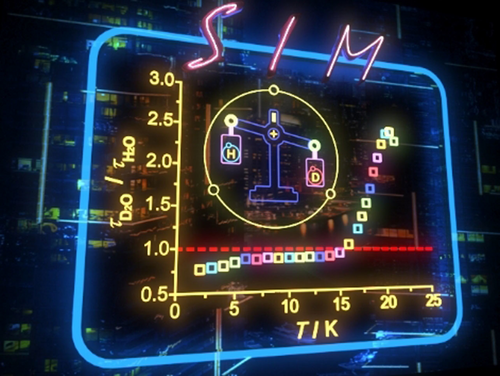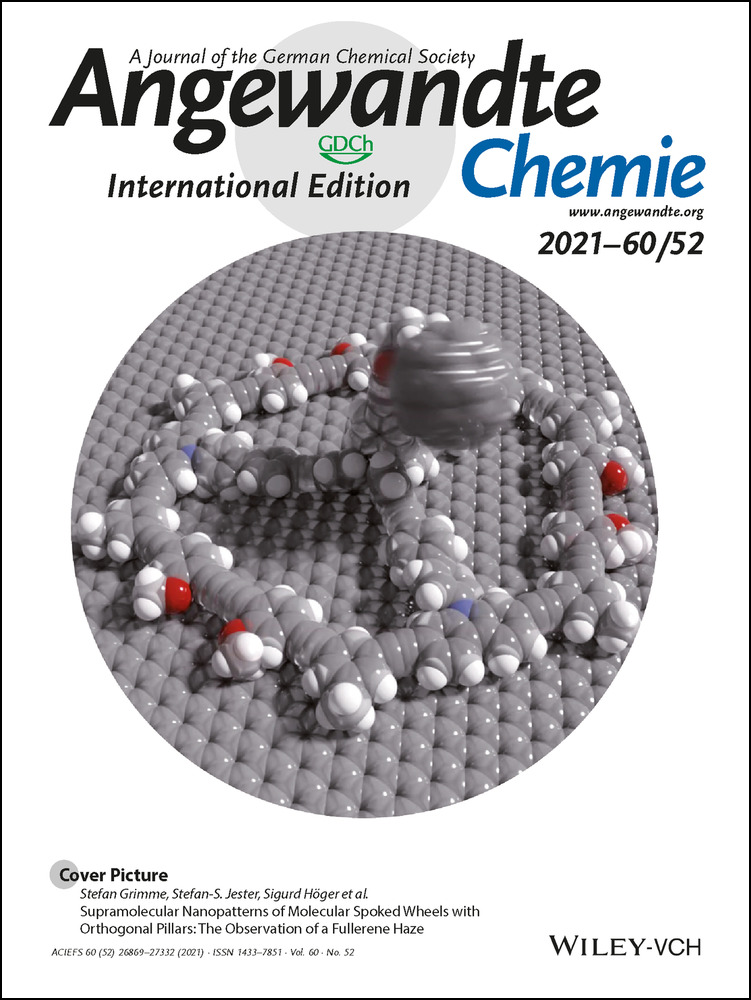Magnetization Dynamics on Isotope-Isomorphic Holmium Single-Molecule Magnets
Dr. Yang Liu
Key Lab of Bioinorganic and Synthetic Chemistry of Ministry of Education, School of Chemistry, Sun Yat-Sen University, Guangzhou, 510006 P. R. China
These authors contributed equally to this work.
Search for more papers by this authorDr. Le Tuan Anh Ho
Department of Chemistry, National University of Singapore, Singapore, 117543 Singapore
These authors contributed equally to this work.
Search for more papers by this authorGuo-Zhang Huang
Key Lab of Bioinorganic and Synthetic Chemistry of Ministry of Education, School of Chemistry, Sun Yat-Sen University, Guangzhou, 510006 P. R. China
Search for more papers by this authorDr. Yan-Cong Chen
Key Lab of Bioinorganic and Synthetic Chemistry of Ministry of Education, School of Chemistry, Sun Yat-Sen University, Guangzhou, 510006 P. R. China
Search for more papers by this authorCorresponding Author
Dr. Liviu Ungur
Department of Chemistry, National University of Singapore, Singapore, 117543 Singapore
Search for more papers by this authorCorresponding Author
Dr. Jun-Liang Liu
Key Lab of Bioinorganic and Synthetic Chemistry of Ministry of Education, School of Chemistry, Sun Yat-Sen University, Guangzhou, 510006 P. R. China
Search for more papers by this authorProf. Dr. Ming-Liang Tong
Key Lab of Bioinorganic and Synthetic Chemistry of Ministry of Education, School of Chemistry, Sun Yat-Sen University, Guangzhou, 510006 P. R. China
Search for more papers by this authorDr. Yang Liu
Key Lab of Bioinorganic and Synthetic Chemistry of Ministry of Education, School of Chemistry, Sun Yat-Sen University, Guangzhou, 510006 P. R. China
These authors contributed equally to this work.
Search for more papers by this authorDr. Le Tuan Anh Ho
Department of Chemistry, National University of Singapore, Singapore, 117543 Singapore
These authors contributed equally to this work.
Search for more papers by this authorGuo-Zhang Huang
Key Lab of Bioinorganic and Synthetic Chemistry of Ministry of Education, School of Chemistry, Sun Yat-Sen University, Guangzhou, 510006 P. R. China
Search for more papers by this authorDr. Yan-Cong Chen
Key Lab of Bioinorganic and Synthetic Chemistry of Ministry of Education, School of Chemistry, Sun Yat-Sen University, Guangzhou, 510006 P. R. China
Search for more papers by this authorCorresponding Author
Dr. Liviu Ungur
Department of Chemistry, National University of Singapore, Singapore, 117543 Singapore
Search for more papers by this authorCorresponding Author
Dr. Jun-Liang Liu
Key Lab of Bioinorganic and Synthetic Chemistry of Ministry of Education, School of Chemistry, Sun Yat-Sen University, Guangzhou, 510006 P. R. China
Search for more papers by this authorProf. Dr. Ming-Liang Tong
Key Lab of Bioinorganic and Synthetic Chemistry of Ministry of Education, School of Chemistry, Sun Yat-Sen University, Guangzhou, 510006 P. R. China
Search for more papers by this authorGraphical Abstract
We reported the nuclear-spin driven magnetization dynamics involving both metal ion and the ligand, for first time, in two HoIII isomorphic single-molecule magnets, where the behavior is originated from the super-hyperfine interaction related to the difference in nuclear spin number of protium (I=1/2) and deuterium (I=1).
Abstract
Here we reported the deuteration of the metal-binding equatorial water molecules in a reported HoIII single-molecule magnet (SMM) with pentagonal-bipyramidal geometry, from [Ho(CyPh2PO)2(H2O)5]3+ to [Ho(CyPh2PO)2(D2O)5]3+. The hyperfine structures originating from the nuclear spin of 165HoIII can be clearly observed. Moreover, the resulting magnetization dynamics revealed the switch of the relative relaxation rates for the two isotope-isomorphic complexes—respectively faster/slower at low/high temperature. The noticeable isotope effect arises from not only the paramagnetic metal center but also the diamagnetic ligands, which can be explained by the ab initio calculated tunnel splitting and the involvement of the super-hyperfine interaction related to the difference in the nuclear spin number of protium (1H, I=1/2) and deuterium (2H, I=1).
Supporting Information
As a service to our authors and readers, this journal provides supporting information supplied by the authors. Such materials are peer reviewed and may be re-organized for online delivery, but are not copy-edited or typeset. Technical support issues arising from supporting information (other than missing files) should be addressed to the authors.
| Filename | Description |
|---|---|
| anie202112764-sup-0001-cif.zip604.7 KB | Supporting Information |
| anie202112764-sup-0001-misc_information.pdf2.5 MB | Supporting Information |
Please note: The publisher is not responsible for the content or functionality of any supporting information supplied by the authors. Any queries (other than missing content) should be directed to the corresponding author for the article.
References
- 1S. Crawford, M. T. Kirchner, D. Bläser, R. Boese, W. I. F. David, A. Dawson, A. Gehrke, R. M. Ibberson, W. G. Marshall, S. Parsons, O. Yamamuro, Angew. Chem. Int. Ed. 2009, 48, 755–757; Angew. Chem. 2009, 121, 769–771.
- 2T. G. Gant, J. Med. Chem. 2014, 57, 3595–3611.
- 3C. Shi, X. Zhang, C.-H. Yu, Y.-F. Yao, W. Zhang, Nat. Commun. 2018, 9, 481.
- 4G. Hummer, S. Garde, A. E. García, L. R. Pratt, Chem. Phys. 2000, 258, 349–370.
- 5E. Sabadini, T. Cosgrove, F. do Carmo Egídio, Carbohydr. Res. 2006, 341, 270–274.
- 6R. Lässer, K. H. Klatt, Phys. Rev. B 1983, 28, 748–758.
- 7M. Kainosho, T. Torizawa, Y. Iwashita, T. Terauchi, A. Mei Ono, P. Güntert, Nature 2006, 440, 52–57.
- 8H. Benedict, H.-H. Limbach, M. Wehlan, W.-P. Fehlhammer, N. S. Golubev, R. Janoschek, J. Am. Chem. Soc. 1998, 120, 2939–2950.
- 9C. L. Perrin, A. Shrinidhi, K. D. Burke, J. Am. Chem. Soc. 2019, 141, 17278–17286.
- 10Y. Zhang, W. Zhang, S.-H. Li, Q. Ye, H.-L. Cai, F. Deng, R.-G. Xiong, S. D. Huang, J. Am. Chem. Soc. 2012, 134, 11044–11049.
- 11S. Koval, J. Kohanoff, J. Lasave, G. Colizzi, R. L. Migoni, Phys. Rev. B 2005, 71, 184102.
- 12S. Scheiner, M. Čuma, J. Am. Chem. Soc. 1996, 118, 1511–1521.
- 13G. A. Jeffrey, An Introduction to Hydrogen Bond, Oxford University Press, New York, 1997.
- 14C. N. R. Rao, J. Chem. Soc. Faraday Trans. 1 1975, 71, 980–983.
- 15J. R. Durig, S. M. Craven, K. K. Lau, J. Bragin, J. Chem. Phys. 1971, 54, 479–487.
- 16A. B. Harris, Phys. Rev. B 1970, 2, 3495–3525.
- 17G. Taddei, H. Bonadeo, M. P. Marzocchi, S. Califano, J. Chem. Phys. 1973, 58, 966–978.
- 18G. J. Kearley, M. R. Johnson, J. Tomkinson, J. Chem. Phys. 2006, 124, 044514.
- 19D. H. Moseley, S. E. Stavretis, K. Thirunavukkuarasu, M. Ozerov, Y. Cheng, L. L. Daemen, J. Ludwig, Z. Lu, D. Smirnov, C. M. Brown, A. Pandey, A. J. Ramirez-Cuesta, A. C. Lamb, M. Atanasov, E. Bill, F. Neese, Z.-L. Xue, Nat. Commun. 2018, 9, 2572.
- 20R. Sessoli, D. Gatteschi, A. Caneschi, M. A. Novak, Nature 1993, 365, 141–143.
- 21M. N. Leuenberger, D. Loss, Nature 2001, 410, 789–793.
- 22N. Ishikawa, M. Sugita, T. Ishikawa, S.-y. Koshihara, Y. Kaizu, J. Am. Chem. Soc. 2003, 125, 8694–8695.
- 23D. Gatteschi, R. Sessoli, J. Villain, Molecular nanomagnets, Vol. 9, Oxford University Press, New York, 2006.
10.1093/acprof:oso/9780198567530.001.0001 Google Scholar
- 24L. Bogani, W. Wernsdorfer, Nat. Mater. 2008, 7, 179–186.
- 25F. Troiani, M. Affronte, Chem. Soc. Rev. 2011, 40, 3119–3129.
- 26S. Thiele, F. Balestro, R. Ballou, S. Klyatskaya, M. Ruben, W. Wernsdorfer, Science 2014, 344, 1135–1138.
- 27F.-S. Guo, B. M. Day, Y.-C. Chen, M.-L. Tong, A. Mansikkamäki, R. A. Layfield, Science 2018, 362, 1400–1403.
- 28W. Wernsdorfer, M. Ruben, Adv. Mater. 2019, 31, 1806687.
- 29F. Pointillart, K. Bernot, S. Golhen, B. Le Guennic, T. Guizouarn, L. Ouahab, O. Cador, Angew. Chem. Int. Ed. 2015, 54, 1504–1507; Angew. Chem. 2015, 127, 1524–1527.
- 30N. Ishikawa, M. Sugita, W. Wernsdorfer, J. Am. Chem. Soc. 2005, 127, 3650–3651.
- 31Y.-C. Chen, J.-L. Liu, W. Wernsdorfer, D. Liu, L. F. Chibotaru, X.-M. Chen, M.-L. Tong, Angew. Chem. Int. Ed. 2017, 56, 4996–5000; Angew. Chem. 2017, 129, 5078–5082.
- 32S.-G. Wu, Z.-Y. Ruan, G.-Z. Huang, J.-Y. Zheng, V. Vieru, G. Taran, J. Wang, Y.-C. Chen, J.-L. Liu, L. T. A. Ho, L. F. Chibotaru, W. Wernsdorfer, X.-M. Chen, M.-L. Tong, Chem 2021, 7, 982–992.
- 33Y. Kishi, F. Pointillart, B. Lefeuvre, F. Riobé, B. Le Guennic, S. Golhen, O. Cador, O. Maury, H. Fujiwara, L. Ouahab, Chem. Commun. 2017, 53, 3575–3578.
- 34J. Flores González, F. Pointillart, O. Cador, Inorg. Chem. Front. 2019, 6, 1081–1086.
- 35E. Moreno-Pineda, M. Damjanović, O. Fuhr, W. Wernsdorfer, M. Ruben, Angew. Chem. Int. Ed. 2017, 56, 9915–9919; Angew. Chem. 2017, 129, 10047–10051.
- 36L. Scherthan, S. F. M. Schmidt, H. Auerbach, T. Hochdörffer, J. A. Wolny, W. Bi, J. Zhao, M. Y. Hu, T. Toellner, E. E. Alp, D. E. Brown, C. E. Anson, A. K. Powell, V. Schünemann, Angew. Chem. Int. Ed. 2019, 58, 3444–3449; Angew. Chem. 2019, 131, 3482–3487.
- 37L. Scherthan, R. F. Pfleger, H. Auerbach, T. Hochdörffer, J. A. Wolny, W. Bi, J. Zhao, M. Y. Hu, E. E. Alp, C. E. Anson, R. Diller, A. K. Powell, V. Schünemann, Angew. Chem. Int. Ed. 2020, 59, 8818–8822; Angew. Chem. 2020, 132, 8902–8907.
- 38W. Wernsdorfer, A. Caneschi, R. Sessoli, D. Gatteschi, A. Cornia, V. Villar, C. Paulsen, Phys. Rev. Lett. 2000, 84, 2965–2968.
- 39J. Li, S.-J. Xiong, C. Li, B. Jin, Y.-Q. Zhang, S.-D. Jiang, Z.-W. Ouyang, Z. Wang, X.-L. Wu, J. van Tol, Y. Song, CCS Chem. 2020, 2, 2548–2556.
- 40F. Luis, M. J. Martínez-Pérez, O. Montero, E. Coronado, S. Cardona-Serra, C. Martí-Gastaldo, J. M. Clemente-Juan, J. Sesé, D. Drung, T. Schurig, Phys. Rev. B 2010, 82, 060403.
- 41E. Moreno-Pineda, G. Taran, W. Wernsdorfer, M. Ruben, Chem. Sci. 2019, 10, 5138–5145.
- 42J. Flores González, H. Douib, B. Le Guennic, F. Pointillart, O. Cador, Inorg. Chem. 2021, 60, 540–544.
- 43J. Flores González, B. Lefeuvre, B. Degraeve, O. Cador, F. Pointillart, Dalton Trans. 2021, 50, 11466–11471.
- 44F. Ortu, D. Reta, Y.-S. Ding, C. A. P. Goodwin, M. P. Gregson, E. J. L. McInnes, R. E. P. Winpenny, Y.-Z. Zheng, S. T. Liddle, D. P. Mills, N. F. Chilton, Dalton Trans. 2019, 48, 8541–8545.
- 45R. Bandyopadhyay, J. H. Nguyen, A. Swidan, C. L. B. Macdonald, Angew. Chem. Int. Ed. 2013, 52, 3469–3472; Angew. Chem. 2013, 125, 3553–3556.
- 46M. R. Pedrosa, J. Escribano, R. Aguado, V. Díez, R. Sanz, F. J. Arnáiz, Polyhedron 2007, 26, 3695–3702.
- 47S. Alvarez, P. Alemany, D. Casanova, J. Cirera, M. Llunell, D. Avnir, Coord. Chem. Rev. 2005, 249, 1693–1708.
- 48D. Casanova, M. Llunell, P. Alemany, S. Alvarez, Chem. Eur. J. 2005, 11, 1479–1494.
- 49F. Aquilante, J. Autschbach, R. K. Carlson, L. F. Chibotaru, M. G. Delcey, L. De Vico, I. Fdez. Galván, N. Ferré, L. M. Frutos, L. Gagliardi, M. Garavelli, A. Giussani, C. E. Hoyer, G. Li Manni, H. Lischka, D. Ma, P. Å. Malmqvist, T. Müller, A. Nenov, M. Olivucci, T. B. Pedersen, D. Peng, F. Plasser, B. Pritchard, M. Reiher, I. Rivalta, I. Schapiro, J. Segarra-Martí, M. Stenrup, D. G. Truhlar, L. Ungur, A. Valentini, S. Vancoillie, V. Veryazov, V. P. Vysotskiy, O. Weingart, F. Zapata, R. Lindh, J. Comput. Chem. 2016, 37, 506–541.
- 50B. O. Roos, R. Lindh, P.-Å. Malmqvist, V. Veryazov, P.-O. Widmark, J. Phys. Chem. A 2005, 109, 6575–6579.
- 51B. A. Heß, C. M. Marian, U. Wahlgren, O. Gropen, Chem. Phys. Lett. 1996, 251, 365–371.
- 52F. Aquilante, P.-Å. Malmqvist, T. B. Pedersen, A. Ghosh, B. O. Roos, J. Chem. Theory Comput. 2008, 4, 694–702.
- 53P. Å. Malmqvist, B. O. Roos, B. Schimmelpfennig, Chem. Phys. Lett. 2002, 357, 230–240.
- 54L. F. Chibotaru, L. Ungur, J. Chem. Phys. 2012, 137, 064112.
- 55L. Ungur, L. F. Chibotaru, Chem. Eur. J. 2017, 23, 3708–3718.
- 56J.-L. Liu, Y.-C. Chen, M.-L. Tong, Chem. Soc. Rev. 2018, 47, 2431–2453.
- 57L. Ungur, L. F. Chibotaru, Inorg. Chem. 2016, 55, 10043–10056.
- 58Deposition Numbers 2110632 (for 1) and 2110633 (for 2) contain the supplementary crystallographic data for this paper. These data are provided free of charge by the joint Cambridge Crystallographic Data Centre and Fachinformationszentrum Karlsruhe Access Structures service www.ccdc.cam.ac.uk/structures.





